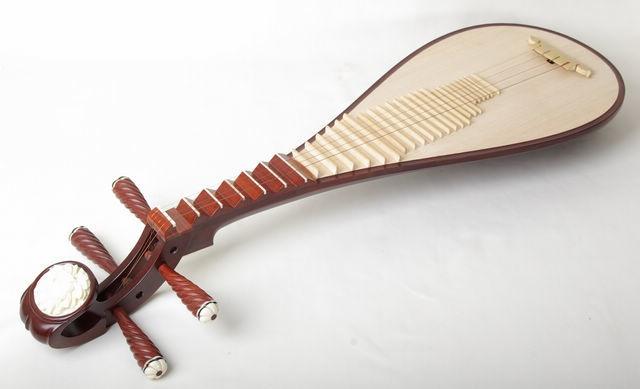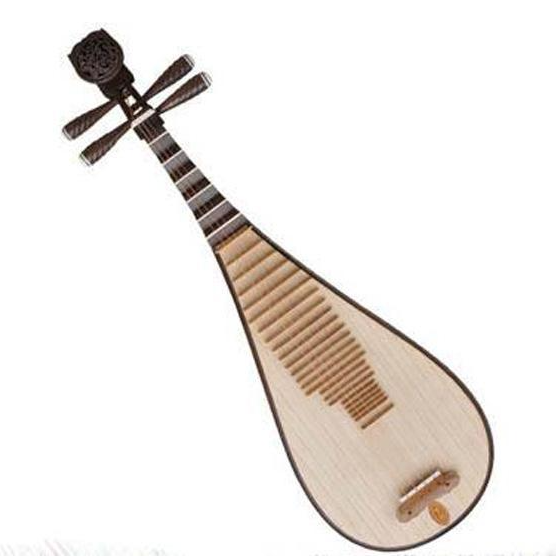The origin of the lute
647 views · Organized by 阿弥 on 2022-02-16
The so-called pipa in history does not only refer to the pipa with a pear-shaped resonance box, but a variety of plucked instruments. That is to say, Pi and Pa were originally the names of two playing techniques. Pi is played forward with the right hand, while Pa is played backward with the right hand. Therefore, the "pipa" at that time were similar in shape and different in size, such as Yueqin, Ruan, etc., which can be said to be pipa instruments.
Pipa is the main plucked instrument with a long history in China. After the improvement of the players, the shape has been unified, and it has become a four-string pipa with six phases and twenty-four frets. The pipa has a wide range of sounds, and its performance skills are the first in national instrumental music, and its expressiveness is the most abundant musical instrument in Chinese music. When playing, each finger of the left hand presses the strings at the corresponding grade, and the right hand wears false nails made of celluloid (or tortoiseshell) and other materials to pluck the strings to pronounce.
Around the Qin Dynasty, a round musical instrument with a long handle began to circulate. Because there are two main ways to play: pop forward and call it "Ba", and pick it backwards and call it "Ba", so people call it "Ba Ba". Later, in order to unify the writing with the qin, se and other musical instruments at that time, it was renamed the pipa.
Pipa is also known as "Battle". It was first recorded in Liu Xi's "Release Names and Musical Instruments" in the Han Dynasty: "Baisai originated from Huzhong, and it was drummed immediately. Before pushing the hand, it is called the batch, but when the hand is drawn, it is called the handle. When the drum is used, it is named because of its name." This means that the batch handle is a musical instrument played on a horse, and it is called a batch when it is thrown forward, and it is called a handle when it is pulled backward; it is named "batch handle" according to its playing characteristics . In ancient times, knocking, hitting, playing, and playing were called drums.
At that time, nomads rode on horses to play the lute, so they were "drummed by horses". The Southern Dynasty King Sengqian's "Technique Record": "Empress Wei Wende Yashan pipa. The Ming emperor tried to use the clothes and beggars as music. When Yang Fu was on his side, he asked the emperor: 'The empress dowager, your majesty's mother-in-law, is the emperor's etiquette wrong?' The emperor felt ashamed. Withdrawing his hands, he came out later. When he leaned over, the emperor said to Fu: 'I know that you are respecting the festival, but since I am uneasy, I will now follow the words of Qing, and I can't see the people of Yi in the vast Xiangshui?' ." It can be seen that in the Wei and Jin Dynasties, the name of "Pipa" officially entered the court.
The pipa evolved from the straight pipa and the Quxiang pipa in history. According to historical records, the straight pipa appeared earlier in China. The "Qin Hanzi" in the Qin and Han dynasties was the straight piece of the round resonance box with the straight handle. Pipa (sound box with skin on both sides), which was developed from the Xiantuo of the late Qin Dynasty. "Ruan Xian" or "Ruan" is a straight-handled wooden circular sound box with four strings and twelve columns, holding a pipa played by hand vertically. Ruan Xian was good at playing this instrument in the Jin Dynasty, so it was named after it, that is, today's Ruan.
During the Northern and Southern Dynasties, cultural exchanges were carried out with the Western Regions through the Silk Road, and the Quxiang Pipa was introduced to China from Persia via present-day Xinjiang. The pipa in Quxiang is pear-shaped with four strings and four phases (without pillars), and is played with a plectrum. It prevailed in the Northern Dynasties and spread to the Yangtze River Basin in the south in the first half of the 6th century AD.
From the Northern Qi Dynasty to the Tang Dynasty, it was the first peak in the history of pipa development. The Cao family of pipa, originally from the state of Cao (now northeast of Samarkand, Uzbekistan), is an outstanding representative, such as Cao Miaoda from the Northern Qi Dynasty to the Sui Dynasty, Pipa was named a king in the Northern Qi Dynasty, and after entering the Sui Dynasty, he was appointed as a music official in the palace, where he taught Pipa skills in Taile.
Among the nine and ten pieces of music in the Sui and Tang Dynasties, Quxiang Pipa has become the main musical instrument, which has played an important role in the development of singing and dancing art in the prosperous Tang Dynasty. From Dunhuang frescoes and Yungang stone carvings, we can still see its status in the band at that time.
Pipa is the main plucked instrument with a long history in China. After the improvement of the players, the shape has been unified, and it has become a four-string pipa with six phases and twenty-four frets. The pipa has a wide range of sounds, and its performance skills are the first in national instrumental music, and its expressiveness is the most abundant musical instrument in Chinese music. When playing, each finger of the left hand presses the strings at the corresponding grade, and the right hand wears false nails made of celluloid (or tortoiseshell) and other materials to pluck the strings to pronounce.
Around the Qin Dynasty, a round musical instrument with a long handle began to circulate. Because there are two main ways to play: pop forward and call it "Ba", and pick it backwards and call it "Ba", so people call it "Ba Ba". Later, in order to unify the writing with the qin, se and other musical instruments at that time, it was renamed the pipa.

Pipa is also known as "Battle". It was first recorded in Liu Xi's "Release Names and Musical Instruments" in the Han Dynasty: "Baisai originated from Huzhong, and it was drummed immediately. Before pushing the hand, it is called the batch, but when the hand is drawn, it is called the handle. When the drum is used, it is named because of its name." This means that the batch handle is a musical instrument played on a horse, and it is called a batch when it is thrown forward, and it is called a handle when it is pulled backward; it is named "batch handle" according to its playing characteristics . In ancient times, knocking, hitting, playing, and playing were called drums.
At that time, nomads rode on horses to play the lute, so they were "drummed by horses". The Southern Dynasty King Sengqian's "Technique Record": "Empress Wei Wende Yashan pipa. The Ming emperor tried to use the clothes and beggars as music. When Yang Fu was on his side, he asked the emperor: 'The empress dowager, your majesty's mother-in-law, is the emperor's etiquette wrong?' The emperor felt ashamed. Withdrawing his hands, he came out later. When he leaned over, the emperor said to Fu: 'I know that you are respecting the festival, but since I am uneasy, I will now follow the words of Qing, and I can't see the people of Yi in the vast Xiangshui?' ." It can be seen that in the Wei and Jin Dynasties, the name of "Pipa" officially entered the court.
The pipa evolved from the straight pipa and the Quxiang pipa in history. According to historical records, the straight pipa appeared earlier in China. The "Qin Hanzi" in the Qin and Han dynasties was the straight piece of the round resonance box with the straight handle. Pipa (sound box with skin on both sides), which was developed from the Xiantuo of the late Qin Dynasty. "Ruan Xian" or "Ruan" is a straight-handled wooden circular sound box with four strings and twelve columns, holding a pipa played by hand vertically. Ruan Xian was good at playing this instrument in the Jin Dynasty, so it was named after it, that is, today's Ruan.
During the Northern and Southern Dynasties, cultural exchanges were carried out with the Western Regions through the Silk Road, and the Quxiang Pipa was introduced to China from Persia via present-day Xinjiang. The pipa in Quxiang is pear-shaped with four strings and four phases (without pillars), and is played with a plectrum. It prevailed in the Northern Dynasties and spread to the Yangtze River Basin in the south in the first half of the 6th century AD.

From the Northern Qi Dynasty to the Tang Dynasty, it was the first peak in the history of pipa development. The Cao family of pipa, originally from the state of Cao (now northeast of Samarkand, Uzbekistan), is an outstanding representative, such as Cao Miaoda from the Northern Qi Dynasty to the Sui Dynasty, Pipa was named a king in the Northern Qi Dynasty, and after entering the Sui Dynasty, he was appointed as a music official in the palace, where he taught Pipa skills in Taile.
Among the nine and ten pieces of music in the Sui and Tang Dynasties, Quxiang Pipa has become the main musical instrument, which has played an important role in the development of singing and dancing art in the prosperous Tang Dynasty. From Dunhuang frescoes and Yungang stone carvings, we can still see its status in the band at that time.
Involving musical instruments
Pipa (pinyin: pí pa), the first plucked instrument, is a traditional plucked instrument in East Asia, a plucked stringed musical instrument. Made of wood or bamboo, the speaker is half-pear-shaped and has four strings on the top. It was originally made of silk thread, but now it is mostly made of steel wire, steel rope and nylon.
Guess you like
Organized by 爱在西元 on 2024-12-17
With the gradual drop in temperature, the cold and dry winter is a special test for wooden instruments such as the pipa. In order to ensure that the pipa can still maintain its best condition and sound quality in the cold season, it is essential to take proper maintenance measures. Here are some important suggestions for winter maintenance of pipa.
read >>
Organized by 赵锦辛 on 2024-10-12
On the evening of October 7, the "Unparalleled Chinese Music · Jinse Dragon Walk" Fang Jinlong Qiuci First performance lecture was held in the high terrace residence of Saksak Street, Kuqa City, Xinjiang, bringing a unique musical and cultural feast to the general public and tourists.
read >>
Organized by 拙 on 2024-08-28
Australian pipa teacher Li Xinyang is promoting the charm of this traditional instrument on the local and international stage with his outstanding skills and love for Chinese music culture. Li Xinyang not only teaches pipa playing skills, but also dedicates himself to spreading the beauty of Chinese rhythm, so that more and more people can understand and fall in love with this ancient Oriental art form.
read >>
Organized by 梦昱 on 2024-08-19
On the evening of August 17, Chongqing Youth Plucked Orchestra held a unique pipa night concert in Jiangtan Park on Beibin Road. Several students from Chongqing, Henan, Sichuan and other places joined hands with the teachers on stage to perform a number of classic pipa songs and modern works.
read >>
Organized by CT. on 2024-08-07
Recently, the 5th Liaoyuan Pipa Culture and Art Week and the 5th "Liaoyuan Cup" Pipa Art Elite Exhibition opened in the Southern New Town Grand Theater of Liaoyuan City, Jilin Province.
read >>
 渝公网安备 50010702504639号
渝公网安备 50010702504639号